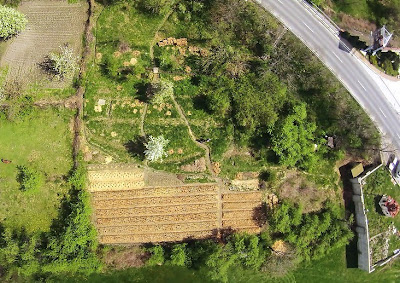Many of the plants we grow I prefer to sow directly outside and one of the most important things to consider when sowing is that the temperature of the soil is high enough for the seed to germinate.
Other important considerations include:
- whether the seed requires any pre-treatment before it will germinate, i.e stratification and scarification (mainly relevant for perennial plants particularly trees and shrubs).
- how deep you sow the seed - too shallow is better than too deep.
- that the correct moisture levels are kept constant during the germination phase - not too wet, not too dry and with the ideal moisture levels similar to that of a wrung out cloth.
 |
| Elaeagnus commutata - Epigeal germination |
This post we'll focus on soil temperature for germinating seeds. We'll look at why this is important, how to take soil temperature, and I've included a table showing the minimum and preferred soil temperatures for germination of some common plants.
 |
| Eruca sativa - Rocket germinating |
Often you will find a monthly guide on a seed pack indicating when to sow seeds and this generally works okay, but can be misleading. If you have a long cold winter and the soil is cold, germination will be delayed and in some cases the seeds may rot in the ground. On the other hand, if the soil is unusually warm in the spring, it's possible to seed earlier. Being able to tell the soil temperature and being aware of the preferences of each plant will result in more or your seeds germinating.
 |
| Tomato seedlings |
Measuring Soil Temperature
Any thermometer that will measure temperature at a specific depth can be used to measure soil temperature. Insert the thermometer into the area where the seeds will be sown and wait a few minutes before you take a reading.
Bear in mind that each area of your garden will probably have a different temperature. The soil temperature is influenced by the following factors:
- Bare soil warms much faster than mulched soil and vegetated soil.
- Dry soil will be warmer than wet soils.
- South facing soils will be warmer than north facing, and the amount of shade cast on the soil will affect the temperature considerably.
 |
| Gingko biloba seedling |
Warming up the Soil
Here's a table providing the minimum and preferred soil temperature for a number of crop seeds and the estimated time it takes the seeds to germinate
Minimum and Preferred Temperatures for Common Crops
 |
| Basil Seedlings |
Regenerative Landscape Design - Online Interactive Course
Want to learn how to design, build and manage regenerative landscapes? Join us for our Regenerative Landscape Design - Online Interactive Course from May 1st to Sep 13th, 2023.
We're super excited about running the course and look forward to providing you with the confidence, inspiration, and opportunity to design, build and manage regenerative landscapes, gardens, and farms that produce food and other resources for humans while enhancing biodiversity.

Regenerative Landscape Design Online Course
You can find out all about the course here and right now we have a 20% discount on the full enrollment fees. Just use the promo code RLD2023 in the section of the registration form to receive your discount.
We are looking forward to providing you with this unique online learning experience - as far as we know, the very first of its kind. If you are thinking of reasons why you should do this course and whether this course is suitable for you, take a look here where we lay it all out. Looking forward to it!
We're super excited about running the course and look forward to providing you with the confidence, inspiration, and opportunity to design, build and manage regenerative landscapes, gardens, and farms that produce food and other resources for humans while enhancing biodiversity.
 |
| Regenerative Landscape Design Online Course |
You can find out all about the course here and right now we have a 20% discount on the full enrollment fees. Just use the promo code RLD2023 in the section of the registration form to receive your discount.
We are looking forward to providing you with this unique online learning experience - as far as we know, the very first of its kind. If you are thinking of reasons why you should do this course and whether this course is suitable for you, take a look here where we lay it all out. Looking forward to it!
--------------------------------------------------------------------------------------------------------------------------
Support Our Project
If you appreciate the work we are doing you can show your support in several ways.
- Make a purchase of plants or seeds from our Bionursery or Online Store
- Consider joining us for one of our Courses or Online Courses
- Comment, like, and share our content on social media.
- Donate directly via PayPal to balkanecologyproject@gmail.com
- Make a purchase of plants or seeds from our Bionursery or Online Store
- Consider joining us for one of our Courses or Online Courses
- Comment, like, and share our content on social media.
- Donate directly via PayPal to balkanecologyproject@gmail.com
 |
| You can also register for our online training, services, and products directly here. |
--------------------------------------------------------------------------------------------------------------------------
References
http://www.rodalesorganiclife.com/garden/plant-seeds-right-depth
















